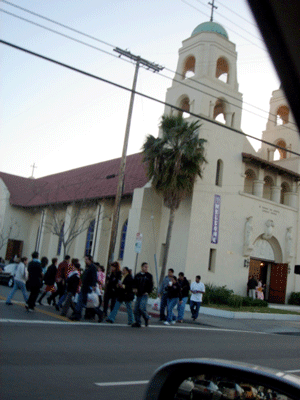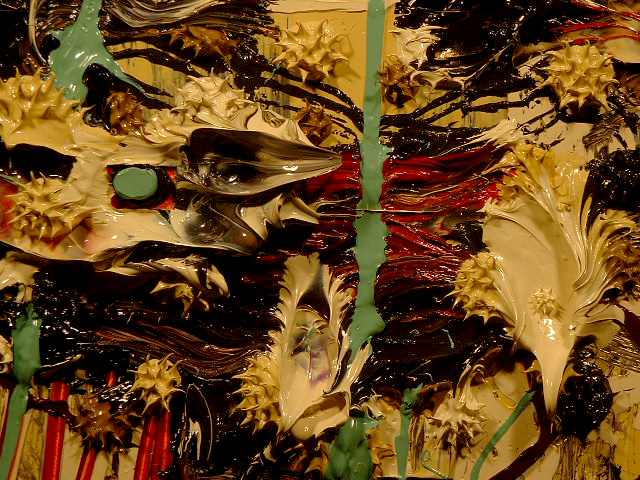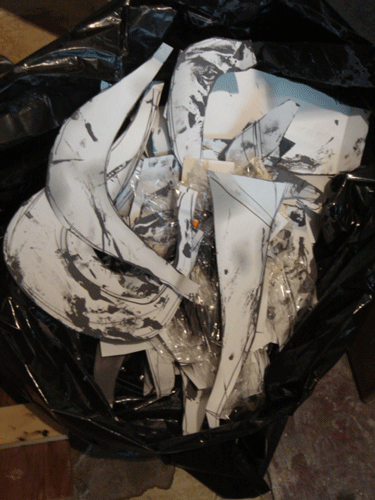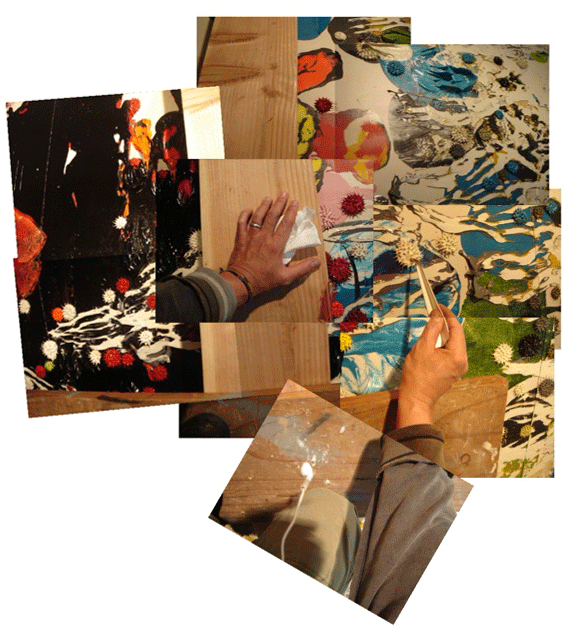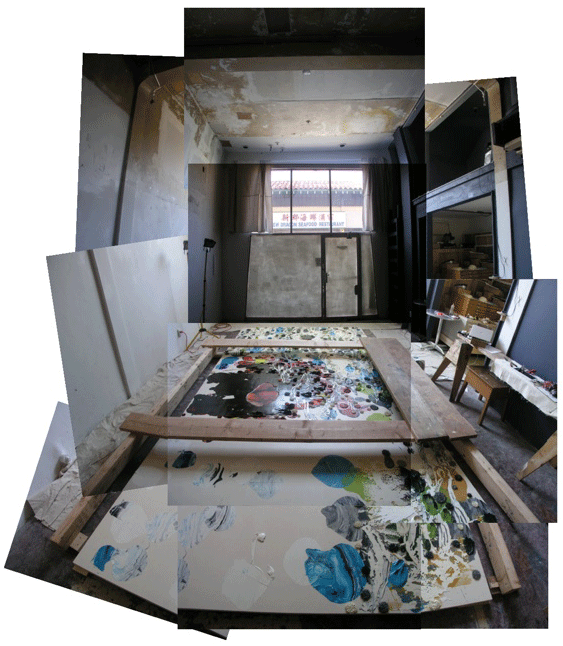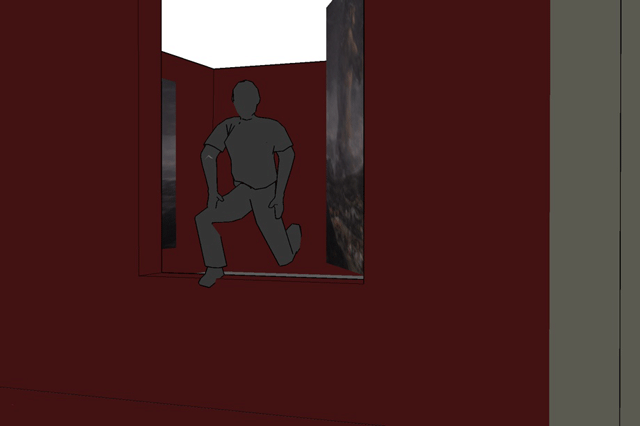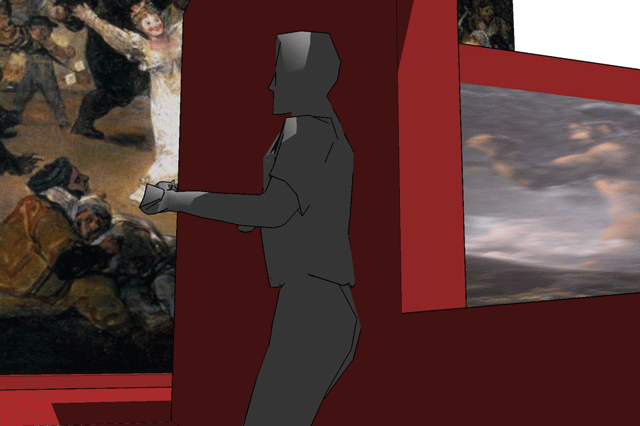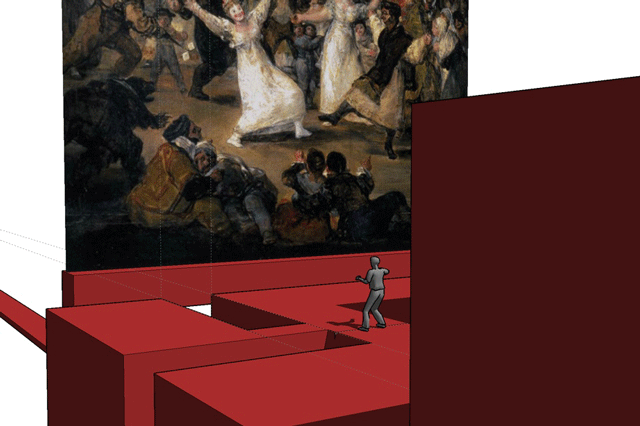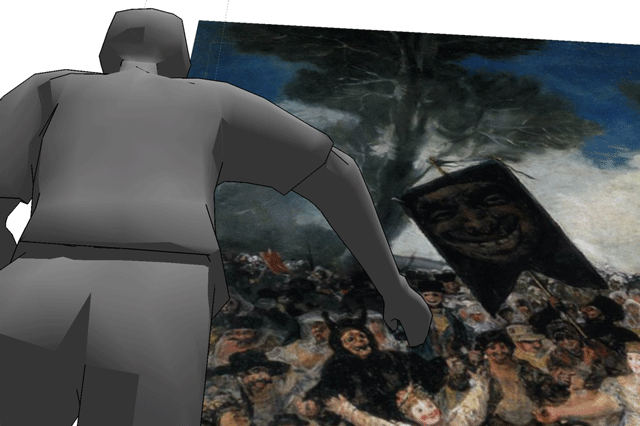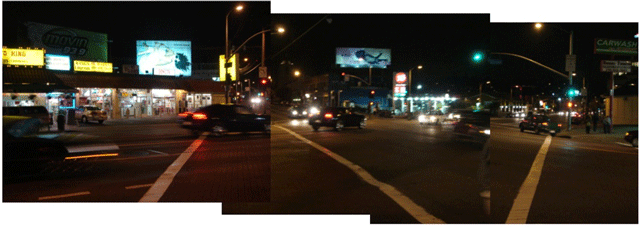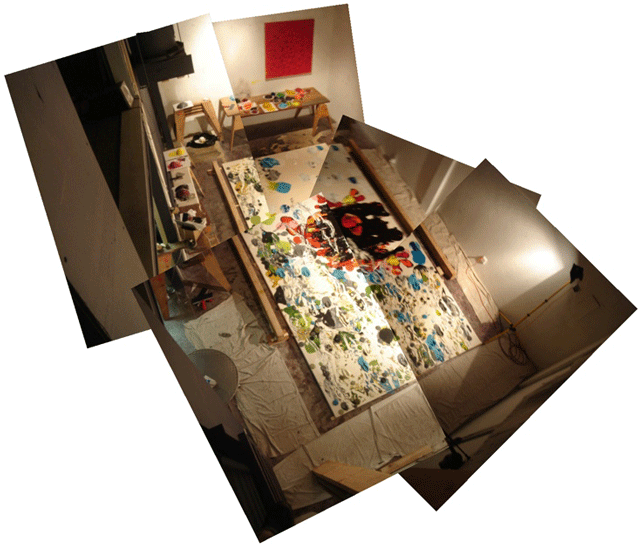February 28, 2007
Contemporary Art and Complicity
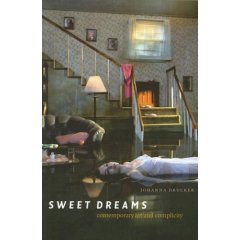
JL, blogger of Modern Kicks (who describes himself in this way:"I'm not too interested in who I am. No need for you to be, either." ...admirable in a Sergio Leone kind of way...) prompted me to buy Johanna Drucker's book, Sweet Dreams: Contemporary Art and Complicity today:
...her main thesis is "that the critical frameworks inherited from the avant-garde and passed through the academic discourses of current art history are constrained by the expectation of negativity. Fine art should not have to bear the burden of criticality nor can it assume superiority as if operating outside of the ideologies it has long pretended to critique." Drucker's target here is not simply or even primarily the old bugbears of modernism, but instead their postmodern successors, especially as articulated in the work of writers around October or influenced by the same. That art should legitimate itself through strategies of opposition toward or escape from society and commerce stands, for Drucker, as a futile, illusory goal. "Ours is a messy condition," she writes: one moment we are reflecting on the highest ends of high art, the next moment we're gossiping about who wore what at the Oscars--and sometimes these activities bleed into one another. Gestures of opposition are expected from artists who turn immediately to the application for grants or the pursuit of sales (not any fault of their own, for we all have to get by in this messy world.) Those same gestures, if alluring enough, are turned into fodder for the culture industry they allegedly defy (I was surprised to see no reference to Thomas Frank here.)After reading this, I let my Amazon 1-click fly.
Familiar enough stuff, at least in part, but what engages is what Drucker does with it. First, she argues that artists in recent years (of the past decade or so) have increasingly accepted this complicity, even embraced it, and gone about creating their work from a viewpoint that acknowledges it. The mix of high and low source material (not in the ironic, distancing manner of pop art, but as equally available sources), of different idioms or media, the broad range of subject matter approached without modern or postmodern anxieties, all these she sees as characteristic of this new art. As a result, the older critical traditions are unable, sometimes comically so, as she shows, to adequately address the work. And if the dream of art as opposition has died, Drucker still believes that art plays a role in changing our perceptions, even if nothing can be seen to follow programmatically from this fact.
(Emphasis Mine.)
February 26, 2007
Roger Dickes' "Another February Skies"
"Another February Skies", a group art exhibition at the Glendale Community College Art Gallery (GCC) opened February 3 and continues through March 10.
Anoka Faruqee, Mike McMillin, John Pearson and Rebecca Ripple are the Los Angeles-based artists. Their works in this exhibition include large format prints by Pearson, a monumental-scale sculpture by Ripple, paintings by Faruqee and sculptures by McMillin.
***
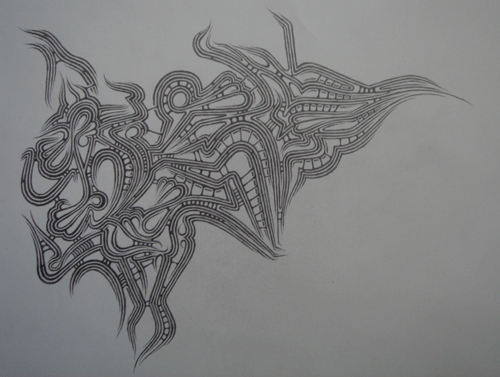
"Axe wielding ghosts."
That's how Roger Dickes aka "Heavyhandz "referred to the top dogs of the art world dialog. We spent the afternoon talking about his work and the arc that led him from an aborted medical degree through art school to his tenured position at GCC and his stewardship of the art gallery there, and his ongoing visual art/musical art studio practice. Roger had gone to school at Art Center and I asked him about the faculty, about the reality of that school's ambition to match and exceed the reputation CalArts had for high octane theory. I mentioned my recent conversation with Jacques De Beaufort, how Jacques took issue with my identification of the powers that be and the label called "postmodernism" I used to lasso them altogether. "That term is meaningless now, Dennis. Art is bigger than that. This is the lesson of postmodernism."
And yet the label persists. How else are we supposed to get a handle on it?
Jacques point was that those who would be our artworld's intelligencia are gone, their arguments have evaporated and while their professional lives have not changed substantially either in the institutions or in the studio. Thier dominance had been superceded... by the global art market, among other things. Not that this is a good thing in itself mind you, one is as vacuous as the other.
Well, what about that visiting artist in school (CalArts, in Jacques' case) who demanded that you take on a political position in your work (and not just any political position, mind you), else your work is meaningless? Jacques' response: "Who cares about his work today, anyway?" I mentioned the recently published "Journal of Aesthetics and Protest" and some thoughts I've been nursing concerning it. Where are they on Jacques' relevancy meter? A shrug. October magazine and its' legacy? Nada. The list went on.
It was Roger's characterization that put a face on it for me. "Axe wielding ghosts."
We must have believed in ghosts when I was in grad school in the very beginning of the 90's. The axes seemed to draw professional blood back then alright, as spectral as our livelihood might be. Was I fighting phantoms of my youth, punching the thin air?
My take on the history immediately after I left school was that in the 90's young artists found success by not taking on thier elders. The Oedipal turn was a no-go. After a decade of continental theory, the mandate to slog through the limited set called intellectual authority evaporated and the vapors of P.C.'d multiculturalism and identity politics fueled the art debate after the fall of the Berlin Wall. Painting was going to come back but it couldn't come back as it was before the postmodern turn: skillz had to be disavowed, a kind of childlike quality must be adopted, naivet? was a plus... at least in LA. Above all, one must not use the word "postmodern". "Nobody uses that word anymore."
But how can you turn the page if you can't attach a name for the chief animating philosophy of the era that needs to be critiqued?
As I like to say: "If you liked high school, you'll love the artworld." Not many people are able to be chosen into the elite class of influential VIP's as they process through grad school, and I propose that this is good fortune in disguise. What I am suggesting is that all of us who were not the annointed in our early years had to craft our own way forward outside of the officially sanctioned discourse... we had to engineer the rudiments of another one, each in our own way. For Jacques, I would say that he had made his break by finding a better authority for the ego erasing track in the anti-modern, postmodern argument: Eastern philosophy. For Roger, I was fortunate in that studio visit to see one of his earliest works from grad school: a text piece where he was able to pry open a slim crack in the edifice and make his escape.
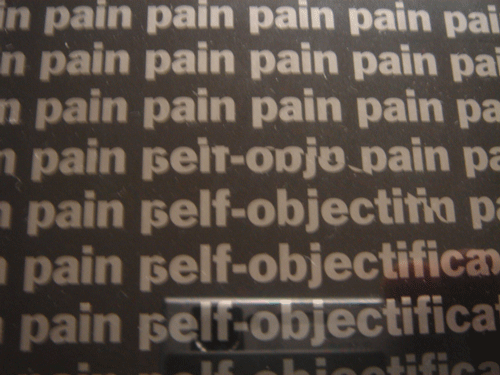
Roger's pre-med start in education was on a psychology track. His father and grandfather worked in that field. We talked about his Judaic heritage (schooled but ultimately secular) and I floated my theory of the close read and the Torah. The image above was a classic artwork of its' time, textual with psycho/philosophical intentions laced throughout. A closer read reveals an invasion of text reading "self objectification" into a field of text reading "pain", and standing back one can just barely read the word "suicide" across seven framed panels. What I focused on (and what I tried to shoot in the foto above) was the discrepancy, that barely perceptible fracture in the facture, a crack in the code from which I believe/project that Roger made his escape from prevailing orthodoxy. I see this piece as Roger's middle finger salute, truth to power.
Everything he did afterward is a departure as far as I can see.
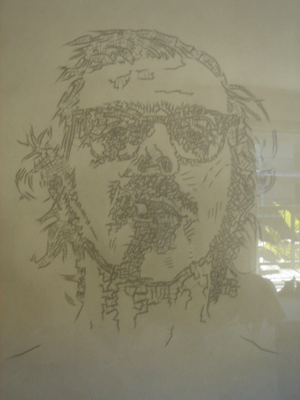
Chuck Close. I was a few years out of school when I realized that my own point of departure was Ed Ruscha... I didn't consciously calculate it this way, but in my strategy of sandwiching image and text, I worked the dynamics of the two aspects in sympathy and not one against the other. For the paintings I made out of school ('91-'95), I treated the text in formal terms, reversing and mashing them, and ultimately relating them to the imagistic substrate below and visa versa. In other words, I reversed the dynamics of the icon of the era I was critical of. Upon seeing Roger's point of departure in his Chuck painting, I felt I was seeing something similar.
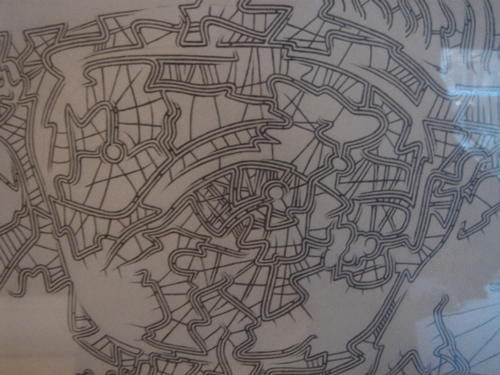
Roger had jettisoned the organizing grid that was central to the C.Close project. In the master's work (C.C.), I tend to see tiny lyrical free form abstract paintings in each little grid. Close can get super freaky and set the freak show in tension with the grid: everyone gets their gestalted image and a chance to lose themselves in a sea of carefree form and color too.
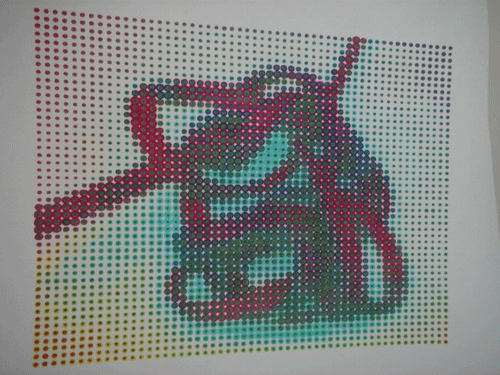
Roger worked the Closian system front to back. Instead of free form freakiness in each cell, Roger systematized it with geometry. Instead of a recognizable image for a gestalt, free form abstraction and no gestalt.
But what happens when you lose the grid?
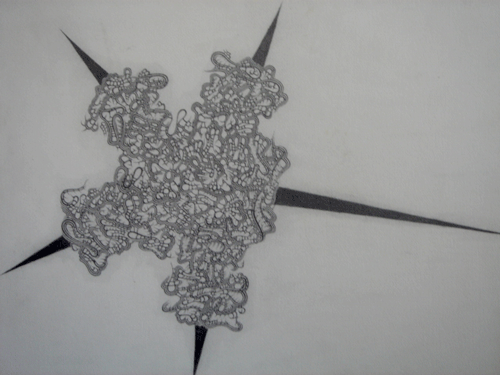
Roger has been mixing music along the way:
Hi Everyone -This is what happens, it seems.Please join me in celebration of my first 12" vinyl release - you
can hear samples if you link here.The party is at the Vanguard in Hollywood on Wednesday, February 28th, where advanced audio playback will be delivered by me and the
accomplished NY disco DJ/Producer Brennan Green, along with
resident DJ's and label owners Lillyanne and Hawkeye. Forget about
Thursday and come dance the night away with us!For all the information about the event, visit Headinghome Recordings.
Some important info about the event:
Goes from 9.30pm - 2.30am
The Vanguard - 6021 Hollywood Bl., Hollywood
RSVP to a $5.00 list to this address headinghomersvp@yahoo.com
The $5.00 list closes at 11pm, so get there early!(Info about Brennan Green.)
-Roger
UPDATE:
Here's a follow up, emails between Roger and I:
Dennis -I think Roger meant that apocalypse/singularity line with a winky emoticon ;-).Very intense, reading your blog entry - to expose my naked self in my work, then to stand exposed before an imaginary public, also through your words. I should have showered and shaved...
Thanks and !ouch! for the Johanna Drucker passage, I have some more thoughts about our discussion:
The redeeming point of anti-expressionistic art could only have been to rail against an unrestrained, irresponsible, self-worshiping egotism. That and/or to "stake out" "new territory" linked to immediate historical context. But to make work that is precisely not about your experience is a poor (ok, temporary) solution to the problem. Better to labor toward a psychological neutrality (humility, colloquially) in the face of whatever self-expressions you make. It's impossible to get there, ugly if you don't try.
I didn't get to say that I think we are past postmodernity/ism. I think of modernism as the fetish of systematization, postmodernity as a zealous recombination. Both phases of cultural production embraced the "new" as a primary goal, with the consequences thereof left to future generations. Which is why we are now in the pre-apocalypse, which can only be transformed by the technological singularity. It could be that the apocalypse and the singularity are the same thing.
What a time to flirt with Warhol's shadow!
-Roger
Wanting to blog his response, I wrote back:
Hey Roger:The last bounce of the email:I did fly my own freak flag a bit in that post, railing against a postmodernity that railed against a modernism that railed against a classicism that railed against a Byzantinism that railed against a... I hope I didn't project too much of my agenda into my rendition of our conversation/ your ideas/ your work. My point was that my/your time in grad school was at the zenith of the postmodern arc and the salient activity for those of us living across the crux betwixt the 20th and 21st centuries is to overhaul and sort out the difference between the two. I think I see this in action in your work, and I hope you see it as the compliment it was intended to be.
I like your admonition: "But to make work that is precisely not about your experience is a poor (ok, temporary) solution to the problem.", it reminds me of what Charlie Finch recently wrote: "The antidote? Take pencil and paper and draw a friend." Sharp stuff. My own formulation of what it means to be modern is: to reconcile the things you make with the life you are living. Thus the modern is different from modernism in that the latter is one step removed from experience/the-life-lived. The problem is that the step-away always creeps up on us, an inevitable part of the human condition. Consequent to this formulation, the job of an artist is to close that step as much as possible, to break the ossification and let the real bubble up even as it crusts up again. What tragic beauty it is to be all too human!
I'd like to append this exchange onto the blogpost, with your permission of course. I'm happy and eager to edit the text and any suggestions are entirely welcome. That's the contradictory beauty of the self published studio diary: even though it is essentially an eternal first draft, it's one that can be revised endlessly!
Una brazos
-Dennis
I agree with the distinction between modernism and the modern, and the way you define the task at hand there. Charlie Finch's little salvo is what my dj peeps would call a "straight bust". Make sure to go thru the bust gallery...
February 22, 2007
Ayaan Hirsi Ali in Six
1.) Ayaan Hirsi Ali speaks about the bright and dark aspects of our time and her relationship with the American Jewish Committee.
Ayaan Hirsi Ali spoke to the American Jewish Committee, Los Angeles at the Creative Artists Agency in Century City, a night to remember. It was striking that the news of her immigration to the USA was played down in the media. I've read different reasons for her departure from the Netherlands, some striving to find a hint of scandal. Her own account pivots on the need to fight the good fight in a language that reaches more people in the world than Dutch, although she was careful to note how wonderful the Netherlands is (I concur, I love that place). She did say that the USA was a fulcrum of the struggle to bring the Muslim world into modernity and as she is someone who is living under a fatwa and is advancing into civilizational storm, it all makes sense to me.
I didn't disable the chime in my camera before the talk began at the CAA for Ayaan Hirsi Ali, so I was reticent to capture the introduction to her talk there. Sometime towards the end, I used the applause as cover to flip open my camera and so I captured six video clips to give you all a feel for what happened last night.
2.) Ayaan Hirsi Ali Q&A: How can we get the message across?
3.) Ayaan Hirsi Ali Q&A: Oil and the War on Terror.
4.) Ayaan Hirsi Ali Q&A: Support from Muslims?
5.) Ayaan Hirsi Ali Q&A: Europe and the War on Terror.
6.) Ayaan Hirsi Ali Q&A: Advice for the USA in Iraq?
February 21, 2007
Ayaan Hirsi Ali
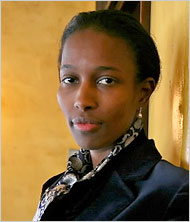
I was lucky to be invited to:
The American Jewish Committee and AJC-ACCESS invite you to
INFIDEL: A CONVERSATION WITH AYAAN HIRSI ALI
Screenwriter and Critic of Radical Islam
Time Magazine?s 100 Most Influential People, Reader's Digest's European of the Year, and AJC's Moral Courage Award Winner
The controversial Somali born feminist and former Dutch Parliamentarian shares her spellbinding personal and political history, her lifelong fight for women's equality and religious reform, and portions of her mesmerizing new book INFIDEL.
Wednesday, February 21 at 7:45 PM
Reception and book signing to follow.
Creative Artists Agency Screening Room
2000 Avenue of the Stars, Century City
Michael Reafsnyder at Western Projects
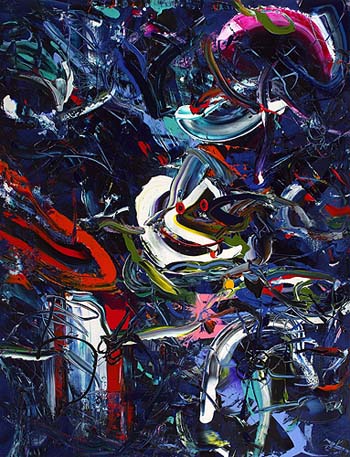
At Michael Reafsnyder's opening at Western Projects in Culver City, I asked owner/director Cliff Benjamin to talk about Michael's work on camera and he was all no way Jose, thus destroying my effort to mug an unselfconsciousness presentation of an artist's work by his dealer.
I don't blame him, I react the same way to impromptu stage fright. The camera is such a conversation killer.
But here is the first part of Benjamin's introduction to Michael's new catalog, published with the exhibition:Michael Reafsnyder is perhaps one of the most peculiar artists I have worked with. His work is unvieled, immediate, preposterous, inventive and magnificent. While many painters are technically proficient, Reafsnyder possesses the additional quality of being a great artist (not all painters are good artists, but that is another discussion). What continually stuns me is his audacity - how did you think of this - how dare you be so happy, i.e. at peace? Who do you think you are? While some might find this trivial - to me, it is deeply philosophical...
Well, that's alright, but I like the Saatchi description better:
Opening tonight is an exhibition by Southern Californian artist Michael Reafsnyder, his first solo show for four years. Comprised of large-scale paintings, drawings and sculpture, 'Aqua La La' is a series of exuberant, energetic works which revel in the use of colour and the texture of paint.Each painting is completed in one session, and what at first might seem a spontaneous, visual equivalent of stream of consciousness writing, is in fact the result of deep thought about the composition of each inch of canvas and the overall structure of each individual painting. One picture might literally bear the weight of hundreds of pounds of oil paint, as it is smeared onto the canvas, creating a sense of chaos - sometimes delicious, sometimes foreboding - which at the same time has its own inner logic.
There is an unapologetic sense of pleasure in the visual in Reafsnyder's work, which is noted on the gallery's press release as 'an antidote in our age of digital graphic glibness'. But this doesn't mean that Reafsnyder's world is an entirely rosy one - the paintings have a dark undercurrent of menace and creepiness in them, which lurks beneath the 'tornadoes of poison and sugar'.
Against the "my kid could do that" dismissal, my responses could be:
1) ...well let's see him do it.
2) Maybe, but not for too many times...
3) Yea, but you couldn't...
4) ...isn't that great?
5) No they couldn't.
The thing about Michael's painting is that it's damn hard to do- that state of flow and resist that you have to maintain to suspend paint in this state of controlled kinetics. "Mud" is the term painters use for incohate color mixing, spectrum chaos, a limit delineating failure. One more touch, another pass and you find that the color of visual noise is brown. Mud is easy to stumble into if you don'tresist it, and Michael doesn't stumble.
The first contemporary comparison that comes to my mind would be the work of Andr? Butzer in Berlin (Cliff B. lists his historical lineage : "...in the footsteps of Asger Jorn, Guston and Dubuffett..."). Michael makes and maintains his connections to painters young an old, figuratively and literally. The upshot is that this kind of painting is not a one shot deal historically. Voices in this vein are layered by generations now, the dialog deeper than what most people would generally assume.
I like to think of painting as the dynamics of opposites in tension. Solvents and binders. Lines and pools. Drawing is a pull that makes distinctions, this is that and that is the other. Pooling (otherwise known as painting) is the ooze of liquid paint, a violation of the territories made by drawing. In Michael's work, drawing and pooling are decoupled and the result is a delightful run amok.
What is supercool is that Michael seesaws from sculpture and back to painting, working the formal dynamics of mass against color and line. In the video, you might see the glazed terra cotta figures as I do: where a kind of lynchpin was pulled out of figural modeling as the masses slump into a coil of line and bellies of color. And it seems to me that the happiness he celebrates is that feeling of paint squeezed out of the tube, fat and wet, floppy and squirty. It's almost as he were painting portraits of liquid paint itself.
February 19, 2007
Rebuild Them!
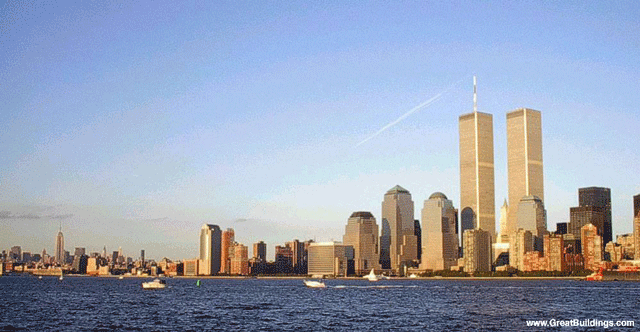
Nicolai Ouroussof had a few incisive things to say about the World Trade Center Freedom Tower in the NYTimes today:
...the widely anticipated announcement that Gov. Eliot Spitzer will support the construction of the Freedom Tower may signal an end to any hope that a broad vision ? or even a level of sanity ? can be restored to a project tainted by personal hubris and political expediency.Remember, bureaucracy is the natural enemy of art:The most recent debate over the tower has centered narrowly on real estate values. With the developer Larry Silverstein set to build six million square feet of office space in three buildings just alongside the Freedom Tower, some have questioned whether it will be possible to lease enough of the $3 billion project at a high enough rate to make it profitable. The tower?s symbolism alone is likely to scare off tenants who will see it as a potential targets for terrorists. The suggestion that we simply pack the building with government offices is almost perversely Strangelove-ian.
Yet the problem is not simply whether enough bureaucrats can be coerced into working there one day; it?s also what the building expresses as a work of architecture. Governor Spitzer may recall the looming presence of the twin towers on the downtown skyline, at once proud and intimidating; the Freedom Tower will have an equally powerful effect on the daily lives of New Yorkers as well as on the city?s image throughout the world. Yet its message will be very different from the old towers.It should be telling that the Freedom Tower is the best we can do at this moment. But we don't have to go there, do we?Hurriedly redesigned more than a year ago after terrorism experts questioned its vulnerability to a bomb attack, the Freedom Tower, with its tapered bulk and chamfered corners, evokes a gargantuan glass obelisk. Its clumsy bloated form, remade by Skidmore, Owings & Merrill, vaguely recalls the worst of postmodernist historicism. (It?s a marvel that its glass skin hasn?t been recast in granite.)
Let's rebuild the original design but with a twist:
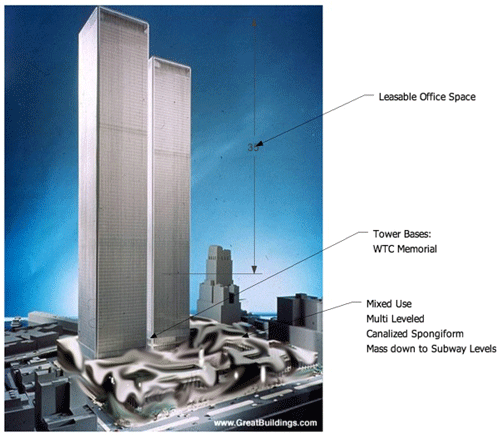
Here's Ouroussoff again:
If built, the lamentable Freedom Tower would be a constant reminder of our loss of ambition, and our inability to produce an architecture that shows a genuine faith in America?s collective future rather than a nostalgia for a nonexistent past.Well, let's make it a real fortress:Nowhere is that failure of ambition more evident than in the tower?s base. In a society where the social contract that binds us together is fraying, the most incisive architects have found ways to create a more fluid relationship between private and public realms. The lobby of Thom Mayne?s Phare Tower in Paris, for example, is conceived as an extension of the public realm, drawing in the surrounding streetscape and tunneling deep into the ground to connect to a network of underground trains.
By comparison the Freedom Tower is conceived as a barricaded fortress. Its base, a 20-story-high windowless concrete bunker that houses the lobby as well as many of the structure?s mechanical systems, is clad in laminated glass panels to give it visual allure, but the message is the same. It speaks less of resilience and tolerance than of paranoia. It?s a building armored against an outside world that we no longer trust.

Strangelove indeed.
For those who need to know: the Phalanx Ornamental Self Defense Gargolye Bots? is a humorous aside. But you know, you could outfit them with industrial sized tasers or a humongous glue gun or something.
Seriously though, nothing elides a formal expression of hunkered down cowardice than standing back up after you've been sucker punched.
UPDATE: Laser Phalanx Ornamental Gargoyle Bots!
We'll now advance these folks displayed as in a trance...
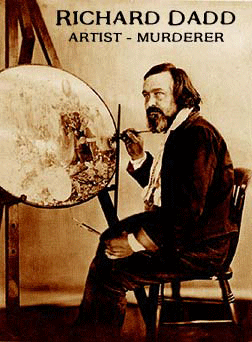
I was reading Jacques' post Rendering, searching for what a nine year painting looks like, who Richard Dadd was and up pops a correlation to the artist <>criminal idea that I formulated on the fly in the post Notes over Coffee for Jacques: "...Some criminals like to pose as artists for elegant cover and some artists like to pose as criminals for the same reason..." --dark confirmation of that formulation. Hitler was a painter, writer and architectural enthusiast. Jean Genet. A graduate class on art and the dark side might be interesting to put together. That'll be good after the pro practice class packed with studies of grifting, confidence games and cults. Nasty stuff, I don't know if I have the constitution to immerse myself in that for a semester, but the art world is at least like the internet, a public way where you meet all types of people.
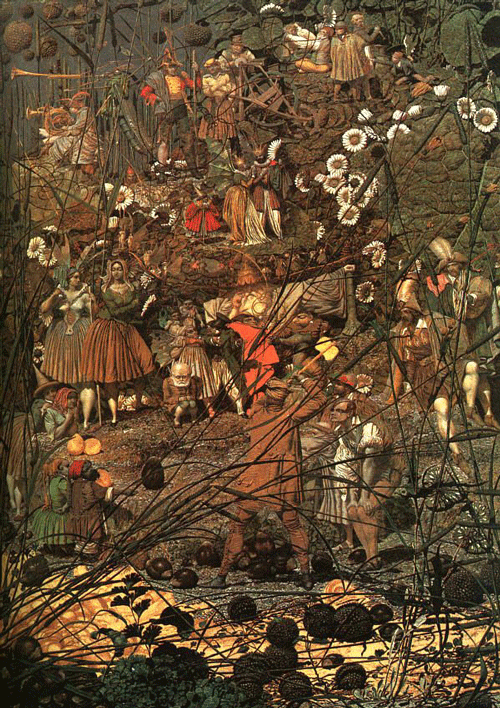
Then I came across another passage that ratified a desire I had for the installation of lighting on my work in exhibition:
There is no possible way that Fairy-Feller can be properly reproduced in any medium. It is literally three dimensional, so thick are the layers of paint that Dadd painstakingly applied. Using a magnifying glass, Dadd worked in minute, obsessive detail, even the original painting, which is in London, a part of the Tate Gallery collection, needs to be displayed with 'raking light' in order to be properly appreciated.(Emphasis Mine.)When Dadd finally stopped work on the painting, he immediately reproduced it in watercolor, and wrote a bizarre verse guidebook for it entitled Elimination of a Picture and its subject - called The Feller's Master Stroke. The guide starts with: "We'll now advance these folks displayed as in a trance...", and goes on to assign each of the hundreds of even minor characters a separate task...
Sheesh.
Yea, he's a kind of blogger too.
Creepy.
Admin: Smurfin'
That last post, "Whew"...
There's a recurrent question as to where the line should be drawn between public and private life in the blog.
The first thing is common sense: the level of confession should be controlled out of respect either for yourself and others if the phrase "too much information" means anything. You have to upload as many decent ideas as possible. There is the test of whether these captured butterflies can become a story or an essay or a notation of a moment of clarity or stuff that catches your eye. And then there's the test of some kind of intuited sense of an index pointing toward art ...the pole of this being a bone of contention among us... but compasses go wanky the closer you get at the poles so I hear. That's the beauty of it all.
But what do you do with scraps like this?:
FeatherweightSaturday:
-Mojito
-cup of wine
-cup of wine
-glass of wine
-glass of wine
-tequila shotSunday:
-destroyed.
-misery.
That's just the way it is.
Metabolic equilibrium can be so precious sometimes.turn to the darkness, away from G-d
to see what you could see
the extemities can only be visited
spelunking
etc., etc.
Not an essay, not a note.
A crumpled piece of paper all smoothed out.
Works on Paper
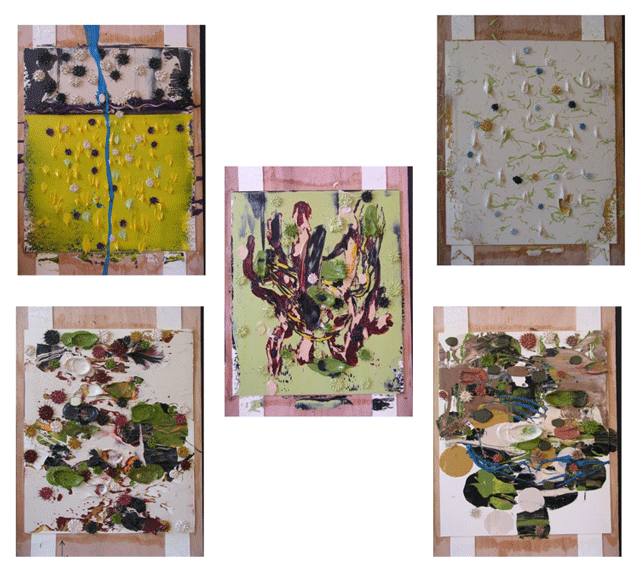
(BLOGPOST IN ROGRESS)
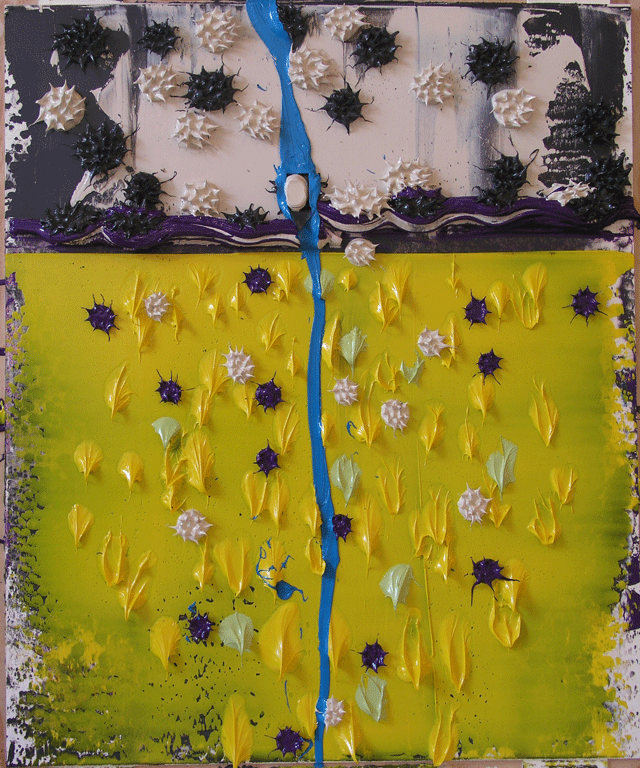

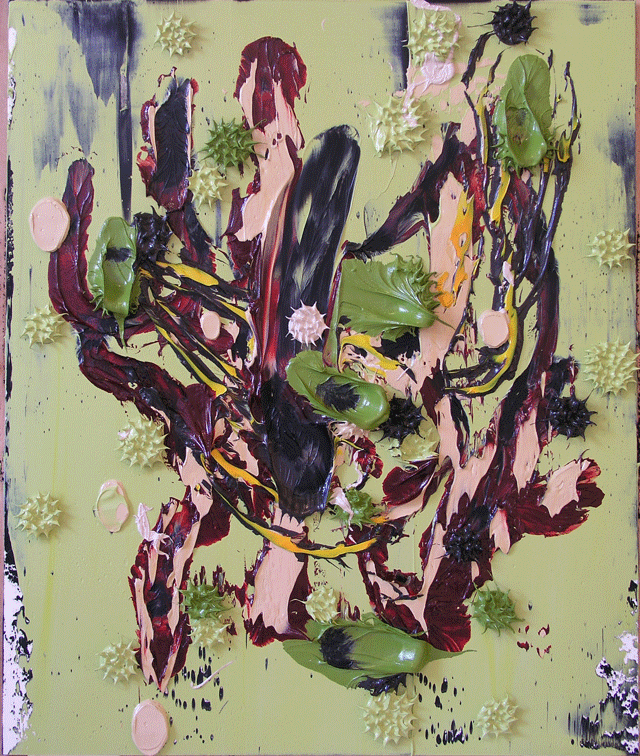

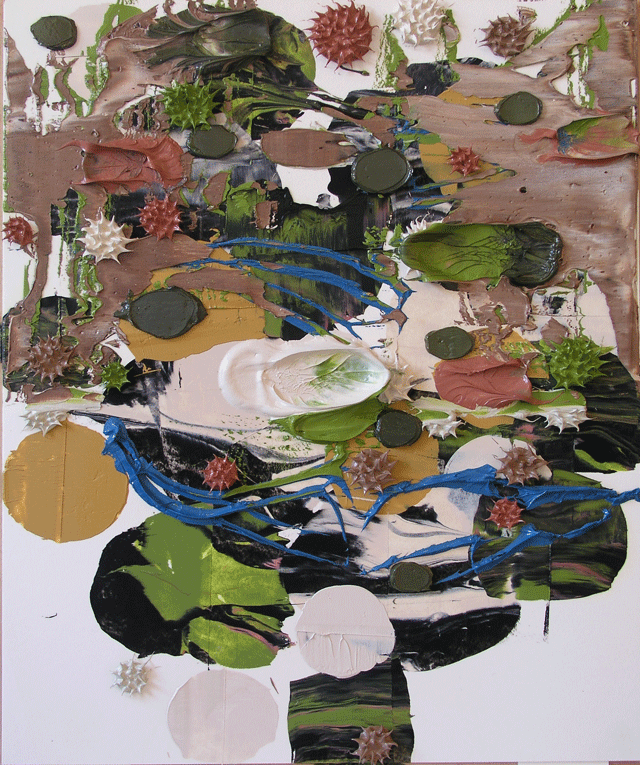
(BLOGPOST IN ROGRESS)
February 18, 2007
Whew
What a weekend.
And I shouldn't write a word about it.
*
*
*
Yet.
("It's Chinatown, Jake.")
February 17, 2007
Notes over Coffee for Jacques
Notes Over Coffee was an editioned project I did with Joel Mesler three years ago whose theme was taken from the communal habit we had of starting our days in ChinaTown with a rendezvous at the local coffee shop. It was common to share newspaper clippings and magazine articles and talk about their significance, conversations full and plump and robust, how great those days were. Jacques deBeaufort was with us on many a morning, and I remember talking about how exciting the phenomenon of blogs were and maybe we should get involved in the new medium.
Now here we are together in the fullness of time and I am happy to see that our Notes Over Coffee has lived on via the internet, plumper and robuster. This post is a kind of dogear of topics that Jacques has touched on in his blog recently, things that I am keen to talk about when we get together this week.
1. I don't think that Jacques is an anti-military type, but I wonder about the drift of his recent post singing a song of praise for an anti-military sentiment dressed up in scholarly garb: "I've been reading a brilliant work by Andrew Newberg,"Why We Believe What We Believe"... " where heros are killers, murderous Islamofascists are humans too, that soldiers kill with a shrug, that our military is no more than a cult. He then excerpts the author's list of 17 steps of indoctrination that results in murderous dehumanization... which is strange since this list could also describe his/our experience in grad school:
When I was in CalArts seven years ago, in some circles it was considered quite wrong to engage in visual pleasure. I wonder if that attitude still persists up in Valencia? I guess it depends on who you talk to...but I'm sure my current work would be torn to shreds in Michael Asher's Post-Studio Seminar. I do wonder if CalArts students still take all that severely puritanical brainwashing to heart. It was always sort of curious to be forced sit and listen- up to 12 hours at a stretch- to a thinly disguised radical leftist critique of commerce*.....especially coming from someone who has lived off of a trust fund for all of his adult life. Daniel Mendel-Black recently commented on Asher colleauge Benjamin Buchloh in a brilliant article. Radicals in any guise are essentially ideologically militaristic. They believe in the absolutes of Truth..and so in a sense remind me of world leaders who couch their policy decisions within the rhetoric of "Good vs. Evil". This is something I have absolutely no tolerance for.Ideological radicals = militarism? It is not uncommon, this reflexive bias within our artworld, our liberal, multicultural, tolerant, intelligent, worldly, broadminded, progressive culture. I remember casual remarks in grad seminars about baby killing soldiers. I remember the ocassional friend who blithely tossed off the idea that soldiers are too stupid to succeed inthe civillian world. Little do they know the dimension of intelligence that there is in the services. I am darkly amused as social encounters freeze when people discover that I was enlisted in the military out of high school, where rage of dinner companions is barely repressed and cordiality devolves into contempt, seething, sputtering. My "tolerant" acquaintances search for signs of apostasy in me against that martial world. It is at that point that I like to say that I made an oath (eyebrows arch) to protect and defend the constitution of the United States (eyes become daggers) and that I still believe in that vow today (conversation frozen, dead). Silence is awkward as I wait for the fool who would repudiate that ideal.
But Jacques is no fool, and I'm keen to unpack this topic over coffee. He is someone who is individual enough to question the answers given to him in school. I see his explorations into Eastern mystisicm as an effort to escape that solipsistic coffin that we have built for ourselves, and I recognise a seeker for a post-postmodern new world. Jacques is a jack-postmodernist too.
2. Jacques is jacking Eastern metaphysics for the tonic that will remedy the ills of our cul de sac aesthetic/philosophical/political cultural order, but the problem is that Eastern mystisicm merely side steps the problem. I recognise that there are many who would dispute this indictment of the status quo, and to this I lay out the fact of the sheer lack of new ideas, the eternal stylistic recurrence of the 60's, the sad reality that education has become based on indoctrination instead of a neutral equippage of intellectual tools to help the next generation to survive in a changing world...
And what is the problem? The problem is that freedom is threatened in this world.
Those of you who would roll your eyes at this point are part of the problem. Some of you are innocently mistaken, misled. Some of you are too scared to stray from the herd. Some of you are a bit dense. And some are simply psychopathic, mild or strong. Real Liberals would not simply dismiss freedom's defense.
In my recent post "The Anti-ist", I had a bit of a problem with this passage from Joseph Joffe's "DISSECTING ANTI-ISMS":
Jews, Indians and Chinese have always embodied the wrenching economic transformation that threatened old habits and dispensations?and Jews suffered twice because they were agents of intellectual and cultural upheaval, to boot.I remember encountering prejudice against Chinese merchants by Filipinos in Manila when I was a kid living in the Philippines (not in my family per se, it was an idea in the air). I remember trying to digest the idea that these were rapacious people, pirates in the marketplace and it took a while for me to puzzle it all out. But this civilizational trio shared the common trait of being uniquely successful economically. Today, we call that entrepreneurship, our new world order. I think that calling the Jews "agents of intellectual and cultural change" is misleading because they are not agent provocateurs as might be implied. Radio talk show host Dennis Prager has an interesting take on the nature of the Jews and their special status as the Chosen People (...his name would send many a Liberal cognoscenti crawling up the walls, stay calm if you can and keep an open mind. That is our claim to fame after all. I assess Prager to be wise despite some shortcomings, and that he offers much of value for those on the Left side of the spectrum...). Prager says that they are not chosen by G-d as the favored child, but as the child who has been tasked with special responsibilities, like taking out the trash or washing the dishes.
Chores.
Work.
Duties.
Their specific responsibilty is to maintain a house for that special meme called freedom. Freedom is the one human property that is set apart by the sanction from G-d. The Chinese and Indians are within the outer zone of this narrative because commerce is predicated on the precondition of freedom. Freedom gives us our right to the property that we create and we take that property to the marketplace to negotiate price and value in the way that Hayeck (--not Salma and certainly not Marx--) describes so well. Artists do this every day. The art world is predicated on this. If property is a crime, then artists are criminals. Some criminals like to pose as artists for elegant cover and some artists like to pose as criminals for the same reason. But if virtue matters, then it's worth considering that the art world would not exist without freedom and the consequent struggle to distiinguish oneself from others.
Jacques, you might not greet this with open arms because the Eastern mystic thing is to dissolve the self. But to that I would say that there is no inherent conflict with the self-manifesting freedom of the Judeo narrative and the mystical paradigm that you are exploring. It's just that there are these other ideologies that seek to dissolve the self for pernicious reasons. Some are the viscious ones of Islamofascism, some are simple yet stubborn patriarchies (bossy men --you know who they are--) and others are the lovely-yet-deadly totalitarian flower that lures with the scent of brotherly love.
Freedom is defined and housed in Judaism, and no where else is this done in the world. Freedom needs the intervention by G-d to remove it to a place safe from meddlesome humans, for intentions good or bad, a denouement for interminable philosophical musing, a literal deus ex machina to make the ulimate abstraction concrete. And because the Jews were chosen to administrate this task, everyone else is free to do as they please, short of burning the house of freedom down. We can all fly our freak flags because that's what freedom implies, because that's G-d's loving gift to the world, because G-d's house has many mansions after all.
So this is why I have trouble with the anti-militarists amongst us. Those who hold our soldiers in contempt are too dense to appreciate the twist of irony as they polish their virtue at the expense of life and freedom of others in the inhuman parts of our world. If it is virtue that scoundrels would steal at the expense of the soldiers of the (Western) world, then the world should know something that soldiers are too noble to admit: that there are few as altruistic as those who would fight for the freedom on mankind's behalf. To be a soldier is to choose something near to a vow of poverty, to be willing to go into harms way so that others can live peaceably. No glamour. No glory. No recognition. Most good soldiers wouldn't even think to ask for it.
Still Sprockets

It has been quite a while since I have been in an architect's office, so it was interesting to see how my fellow design professionals are comporting themselves nowadays, thanks to Gawker:
The Banana Republic ad with the architects?it's everywhere! And it raised some questions for us. So we asked an architect?we'll call him Frankie Lloyd?who works at "a large firm downtown with an eccentric, megalomaniac starchitect at the helm" how the ad stacked up to his reality. The answers may surprise you!Nothing's changed.
Gawker: So have you seen those Banana Republic ads?
Frankie: No, I haven't.
Gawker: Okay, pick up a copy of any magazine. Well, any medium to highbrow magazine -- the New Yorker or New York mag will work well.
Frankie: Yeah, OK. I saw the one inside the cover of this week's New Yorker.
Wow, the colors of those shirts are very bright!Gawker: So what is it like being surrounded by nubile 23 year olds in khaki coordinates at all times?
Frankie: I am not really sure, to be honest with you. I think I may be involved
in some different types of architecture than these people.Gawker: What do you mean, it's not really like that?
Frankie: Well, firstly, these people look really well-rested and almost obscenely casual. If this were a real meeting, the model on the table would have some stray marks on it. More likely, it would be shattered in a million pieces on the floor.Also, in my experience no architects dress like that - the Liebeskind eyeglasses and black turtleneck/blazer, German expressionist style is still the bottom line at most nyc offices. Most people are executing variations on this basic Sprockets-y theme.
Gawker: Well, you guys do spend a lot of time in the airy conference room overlooking the Hudson, staring at little wooden dollhouses and making flirty-eyes at each other, right?
February 15, 2007
Ahora

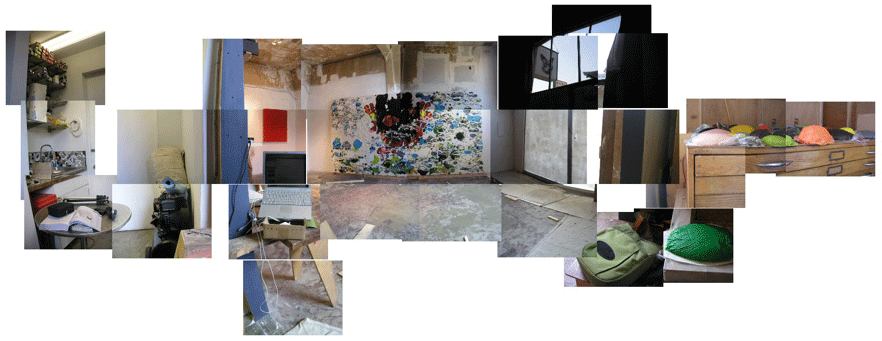
I'm trying to take the fotos so that you can get the feeling of being underneath the painting. Maybe you could print out the image above and tape each end to your temples to get a simulated being-there effect.
C'mon.
The Anti-ist
I've kown anti-Americanism all my life. I've grown up with it.
A slew of articles have been coming out this topic, this is one I found particularly striking today:
Anti-ism is also a response to seduction. After all, why would people freely flock into McDonald's, wear Levi's, drive SUVs and watch Hollywood shlock? The problem with America's enormous "soft power" is that we hate the seducer as we hate ourselves for yielding to temptation. From there it is but a short step to the unconscious remedy of projection and displacement: Blame the source of all these attractions that demote your own time-honored achievements. Hence, any anti-ism comes with the demonization of the "Other" as a way of revalidating oneself.Adn so I have told my friends overseas: "We are family in our modern world together. The differences are not as great as it seems.Power, be it soft or hard, makes enemies?that is the long and the short, but not the end of it. For America was a target of resentment long before George W. Bush?even as far back as the early days of the Republic when it was still weak, as were the Jews in Europe throughout (and the Indians in Africa or the overseas Chinese in Asia). What, then, might be the common denominator of all these anti-isms?
Jews, Indians and Chinese have always embodied the wrenching economic transformation that threatened old habits and dispensations?and Jews suffered twice because they were agents of intellectual and cultural upheaval, to boot. Unlike such high-achieving but highly vulnerable minorities, America has always presented an XXL version of this threat to the rest of the world?as the very steamroller of modernity. And at no time has it flattened as many old ways (and profits and privileges that go with them) as it has at the turn of the 21st century, when it was at the height of its power, hard and soft. Such Behemoths are sometimes respected, always feared, but never loved?especially not by those who once were giants in their own right.
Some anti-Americanism will surely be muted by wiser American policies that reduce the (rational) fear of American power unbound. But au fond, anti-Americanism is not about America. At heart, any anti-ism is a crisis of collective self-esteem that cries out for compensation, be it by extolling one's own culture or by denigrating the Other's. Hence the vexing limits of a rational-empirical debate. For if such a discourse were indeed constructive, it would soon turn to the real causes of misery?those the anti-ist seeks to conceal from himself as he projects them onto the Other.
Just Another Day... and then, Armed Combat.
Imagine burping a spaghetti dinner one day as you browse for a birthday card, and then...
This story didn't stand a chance next to Anna Nicole. But have you noticed how the news tends to sit on this kind of thing?
Nothing to see here, move along now.
February 14, 2007
Pop Spain
Spanish pop culture 101: the top ten Spanish celebrities via Notes From Spain.
Click here and work back via a url trim to earlier posts. Their blog has a wierd set up. Notes From Spain has an excellent podcast that we use to learn Spanish.
My favorite celeb: The Dutchess of Alba, of course!
Notes From Spain's David Hall:
Multiple Zero-Sum Struggles

***
I was riveted by Ralph Peters' rendition of the complexity of Islam in the Middle East and the richness of Persia (it is significant that the intricacies that he delineates excludes Indonesia, Malaysia, the Indian subcontinent, Europe, Africa...). It was difficlut to find a single representative paragraph, so a big chunk of his essay follows the jump:
UPDATE: Check this out: "5000 years of Imperialism" via SandMonkey.
...those most anxious to condemn Islam in its entirety skip over annoying facts: Overwhelmingly, the victims of Islamist terror have been other Muslims; even the Taliban or the Khomeinist regime never rivaled the Inquistion's ferocity; and Europeans, not Muslims, long have been the heavyweight champions of genocide (with the Turks a distant runner-up).All monotheist religions have been really good haters. We just take turns.
But the biggest obstacle to establishing the Caliphate in California is that Shi'a "Islam" never bought into the Caliphate at all. At bottom, it's a different religion from Sunni Islam. They're not just different branches of a faith, as with Protestantism and Catholicism, but separate faiths whose core differences are more-pronounced than those between Christians and Jews.
Technically, Sunni militants are correct when they label the Shi'a "heretics." Persians and their closest neighbors, with long memories of great civilizations, were never comfortable with the crudeness of Arabian Islam--which the anthropologist Claude Levi-Strauss aptly called "a barracks religion."The struggle has never ended between the ascetic, intolerant Bedouin faith of Arabia, with its fascist obsession on behavior, and the profound theologies of Persian civilization that absorbed and transformed Islam. While Shi'ism only prevailed in Persia within the last millennium (nudging out Sunni Islam at last), "Aryan" Islam had long been shaped by Zoroastrianism and other ineradicable pre-Islamic legacies.
Persians made the new faith their own, incorporating cherished traditions--just as northern Europeans made Christianity their own through Protestantism. It's illuminating to hear Iran's president rumor the return of the Twelfth Imam, since the coming of that messiah figure is pure Zoroastrianism, with no connection to the Koran or the Hadiths.
Even the rhetoric of Iran's Islamic Revolution, condemning the U.S. as the "Great Satan" divided the world into forces of light and darkness--Zoroaster again, as well as Mani, the dualist whose followers we know as "Manicheans." Iranians excitedly deny such pre-Islamic influences--then worship at the ancient shrines of re-invented saints, celebrate the Zoroastrian New Year, and incorporate fire rites into social events.
The Prophet's attempt to discipline Arabian hillbillies produced a faith ill-fitted to Persia's complex civilization--or to Mesopotamian Arabs, who despised the illiterate desert nomads. Islam was bound to change as it occupied this haunted real estate.
What we've gotten ourselves involved in today is an old and endless struggle between the desert and the city, between civilization and barbarism. Long oppression may have made Shi'ism appear backward, but it's inherently a richer faith than Sunni Islam. With its End-of-Times vision, founding martyrs and radiant angels, its mysticism and wariness of the flesh, Shi'ism is closer to Christianity than check-list Sunni Islam ever could be.
Further confounding the strategic situation, there are other, parallel struggles within Shi'ism and Sunni Islam. Over the centuries, both faiths developed sophisticated urban classes that are now under assault, as they periodically have been, by intolerant simplifiers preaching the reform-school Islam of seventh-century Arabia.
Simultaneously, there's been some bizarre cross-fertilization: Osama bin Laden, a Sunni who hates the Shi'a more fiercely than he does Americans, has grafted a Shi'a End-Of-Days vision onto Sunni Islam. Meanwhile, the mullahs who locked down Iran obsess about behavior--a Sunni approach to faith--at the expense of Shi'ism's tradition of inner luminosity (in the Sunni world, the persecuted Sufis were the mystics).
We're a fringe player in multiple zero-sum struggles: Persian Zoroastrianism in Muslim garb vs. Bedouin fascism; multiple insurgencies within the Sunni global campaign to re-establish the Caliphate; an interfaith competition to jump-start an apocalypse; an old ethnic struggle between Persians and Arabs; and a distinctly Zoroastrian struggle between good and evil (alert the White House).
I would take exception to the second paragraph: "All monotheist religions have been really good haters. We just take turns.". Judaism? Genocide, religious wars, inquisitions, pogroms, proselytism... I don't think so.
February 13, 2007
Admin: MailCall
Due to my monomaniacalness during the past month, painting the big canvas, I have placed much admin chores on the back burner. I apologise for the continued lame and busted comment function in this blog... but truth be told, I am super wary of the comment spam. I will wish upon a star/say a prayer/kill a chicken (or just eat one) for some solution to present itself someday soon. Or maybe I'll find some web genius to slueth their way into a solution.
Until then and without further adieu, the mail bag...
(By the way, I have a sum total of two emails. People are probably trained away by the broken comment engine. As it is, I am grateful for them.)
John Holdway wrote:
Hi Dennis
I like what you are thinking about. skillz- the would be artist should create their own skill training regimen. A sculptor would learn more about metal fabrication at a community college than from any 25 year old MFA art professor. An art school could be half poly-tech and half art history and philosophy.A different approach would be to train an artist to access technical trades men as an architect does the building trades. The artist as the mastermind directing metal fabricators.
Post Studio sits in the chair of an engineer without scope or experience to know what is possible.Where is the art for the artist? Is it purely in the concept or does it flow from the process of making? The art is the process for the artist and the product for the audience. The product may 99% concept but takes some form to bridge the mind gap.
John Holdway
What I was driving at was how the duality between techinique/materials and intellection (I'm avoiding the term, "theory", but that's the target anyway) is more complementary than antagonistic. I want to find ideas through the physical artwork, in its' making and in its' presentation... and conversely, I want to find the making or physicality through a traffic with ideas.
The trouble with teaching specific technical trades is that this might jump the gun on the conceptual lead... that the kids would get too deep in specialities before they learn how think and thus harness their inspiration. I'm sympathetic to your suggestion that art education might find inspiration in architecture curriculum, and I hope that this is not only because I am an architect. Architects learn enough about various other disciplines in order to conduct a credible conversation with engineers, contractors, material suppliers. With traditional media shifting so rapidly (who learns bronze casting in art school anymore?), teaching systems and strategies for managing the intersection between conceptualization and material systems might be the way to go.
Nah, that idea would blow the brains of most art educators anyhoo.
But it is worth contemplating that art education, with its format set in the 15th-19th centuries, is due for an overhaul in these asymptotic times. I mean, look at this marvelous world that we are creating!
(Listen to me and all this fancy talk, as I sit amongst bottles of damar and linseed oil.)
ps: funny video.
***
Daniel Flahiff wrote:I really love the ?work-in-progress? collages you do on your site? Ahora, etc.
Keeps me coming back and I?m thinking of ripping it off, if you don?t mind, of course?
Daniel
Daniel, rip away! I'm ripping Picasso, NASA, Gordon Matta-Clark and David Hockney as it is.
Nice blog, by the way.
Art After Before and After
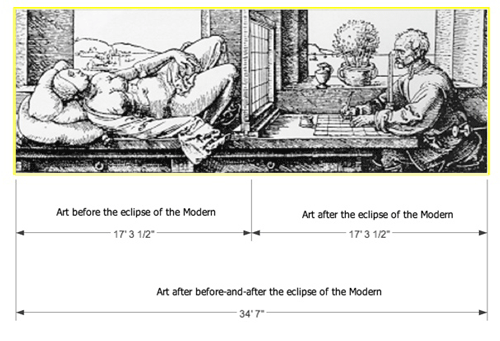
Apropos to the previous post, I remember a story from a friend concerning a studio visit by Paul McCarthy. She was attending a prestigious post grad studio program. She was making sculpture in a serious vein, some people might call it too old school, too modern for our postmodern times. So I was keen to hear what Papa Smurf had to say during his visit. Her report: he said that perhaps she should install a video camera and record herself making her artwork.
She was irritated by his response, every artist who has been an art student knows the feeling. But I thought that Mr. McCarthy was rather gentle and generous to her... and most of all, his recommendation was powerful. He was advising her to include a self conscious dimension to her practice and his strategy was simple, direct and not unfriendly to her current formalist language.
In my version of recent art history, I like to paint the turn from the modern to the postmodern in this way:
In short, this is a description of how the modern became the postmodern in recent art history. Here are a few points to pin a few ideas together:It is important to be able to define what it is to be modern. (It is amazing to me how many people in either the art or architecture worlds can't do this!) Here's my definition: To be modern is to reconcile the life you are lilving with the things you are making. This perspective is most certainly a reflection of my architecture undergraduate degree. The general view of the emergence of the modern in architecture is one of the disruption of the canon by rapidly developing modern technology. New building materials and techniques required an attempt to reconfigure a classical canon into a new (contemporary) one. Over time, efforts continued to fail as new innovations continued to disrupt any attempts to craft a stable narrative.
There are many other voices and narratives (one of the points of Danto's speech, as I uderstand it), but I tend to think of the modern project generally as a reach for transcendance, in blunt terms: to attempt to touch G-d through material means.
There was a crisis at the end of the fifties. Young artists like baby Warhol, baby Rauschenberg, Baby whoever-was-destined-to-contribute-to-Pop Art... they looked at the Rothkos, the DeKoonings and other greats and realized that they weren't going to touch G-d any better than the grizzled masters. So they took the Oedipal turn and flipped the paradigm:
Instead of touching G-d through material means, they endevored to touch everyday life through conceptual means.
This would include baby McCarthy too, even if this was ten years after the turn. His brilliance was to shift art from the world outside to his world inside. And speaking of insides, here is an aside: it is interesting to note -but not to linger on the fact- that he is a Jack-Mormon:
Raised in the Mormon faith and culture, McCarthy insists, "I don't think it was different from any other small community in America. Was it sexually repressed? Probably not much more than other towns in America in the '50s... I kept the issue of the Mormon Church out of my art because it was too much a way of pinpointing (my background) as opposed to what I think about issues of conditioning and consumerism in America."I went to high school in Las Vegas, where there lives a remarkable population of Jack-Mormons, great people, interesting and lots of fun.
*
*
Moving along, nothing to see here, people.
*
*
I don't completely believe in the end of history and that the universalization of Western liberal democracy as the final form of human government would necessarily result in an eternal recurrence to hippy 60's a.k.a. progressive pop cultural philosophy. Every time the spring of culture has cyclically renewed itself recently, it has reinterpreted 60's pop culture in one way or the other. I'm reaching my limit on my ability to reappreciate the 60's. Pop culture may be a result of Western liberal democracy but it should not, it cannot be the only result, the fiinal form. In other words, the final form of human government should be tested by the capability to inspire endless forms of cultural production.
So the question is: can there be another chapter to art after the 60's popped? How can we move on?* Or are we condemned to dutifully scribe footnotes and expand pop culture's bibliography? The addition of the concept of zero to the canon of mathematics was a true revolution, so too was the invention of negative numbers. Go Coprenicus, let Galileo damn the church. Every time humanity comes up to a wall conceptually, we pull a rabbit out of our hat and reinvent the game. So too was the turn from the modern to the postmodern a brilliant moment, incredible it was.
Can we pull the rabbit out of our hat again? Can we be Jack-postmodernists or are we yet too pious to raise a ruckus anymore?
*(I'll let the illustration above suggest my answer.)
A Whole New Level
Just when people start to predict the sunset of ChinaTown, things get a whole lot more exciting. Papa Smurf is coming to town. More news to come of course.
Great videos here.
February 12, 2007
Union Station
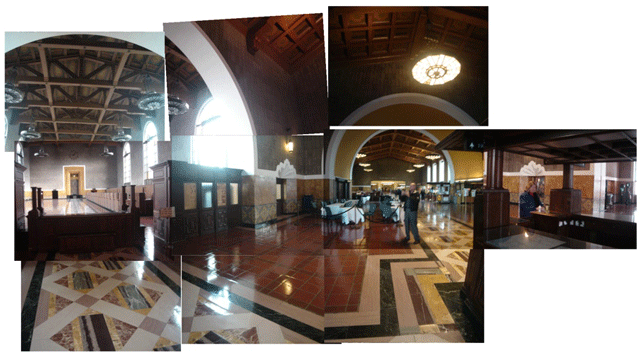
A good friend asked me if I could dust off my architecture license and render some advice concerning the possibility of building a studio on his property. It turned out to be a no-go situation... par for the course.
And so it goes.
I generally tell people that I have taken architecture and stuffed it up into my lower chakra. A wink, a nudge, but I'm serious too. I'll never say never but I will keep that capacity in the root chakra rather than wield it for something that is less than inspiring. (No reflection on my friend who greatly inspires me. It was the framework of the situation that did not favor the architectural move.)
So on this day, I scootered over to the Budget Rent a Car at Union Station and paid for a ride to my friend's place, a visit to the building department to find the parameters that would eventually kill off our field of dreams.
Pues, nada.
Our consolation: this montage of LA's finest architectural treasure, Union Station.
February 10, 2007
Gallery Tour: the Cul de Sac
Continuing with my ever evolving video adventure, I visit the troika of galleries nested in ChinaTown's Alpine Street cul de sac.
Since I have yet to perfect my video correspondent narrative technique, a few notes follow:
(in the order of encounter)
-Joel Mesler's PruessPress (Joel is in New York, opening up another branch of his famed Rental Gallery), a publishing house manned by Matt Chambers, owner of...
-TRUDI Gallery, this month featuring Chris Limponi
-(Matt was out to see what the hubbub was all about at the David Hockney opening at LA Louver that night, therefore the lights out on Chris' show.)
-David Kordansky Gallery, featuring Samara Caughey
-Dan Hug Gallery, featuring Florian Morlat (front room) and Matt Fishbeck (back room). I got to see a few more Fishbeck's pieces (using computer based collage technique), good stuff that.)
February 9, 2007
Delicious Sardines
Conversations about art these days usually hazard the gutterball of professional market talk. Figuratively speaking, most of us are eating out of sardine tins next to bacchanalian banquets... it can be difficult most times to remember how healthy sardines are for your system.
Here are a few items from the Art Newspaper and ArtNet's Magazine concerning the dragon-like nature of our artworld/art market:
Robert Storr: "...As the saying goes, money talks, but generally, when it comes to art?s substance, it doesn?t have much to say. "
Jerry Saltz: "...At the end of the day art still has a private inside and a public outside. It still exudes an alchemical otherness...."
Charlie Finch: "Yes, everyone is making money, but the money is really making them."
Dragons in Our Heads
"...our brain has made an assumption about the structure of the dragon's head..."
(via the Speculist.)
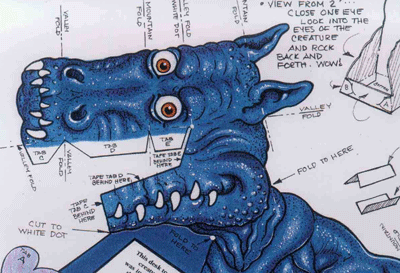
(Paper cut out here.)
February 8, 2007
Se Acab?
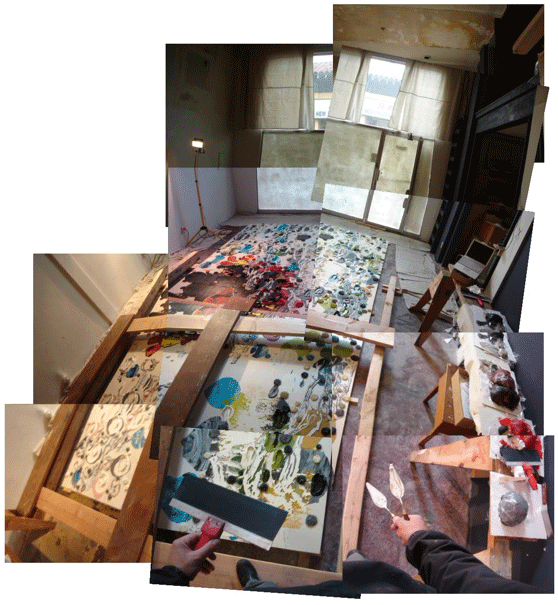
By and large, I'm done.
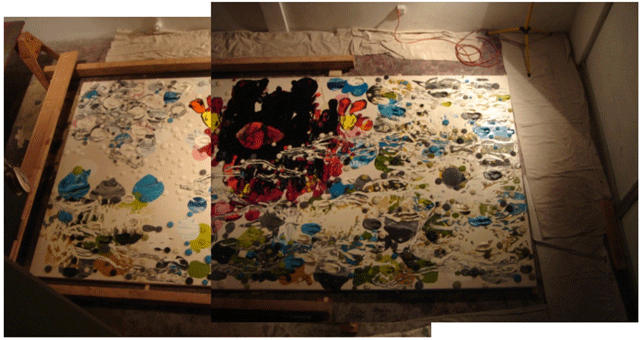
There might be a few tweaks here and there.
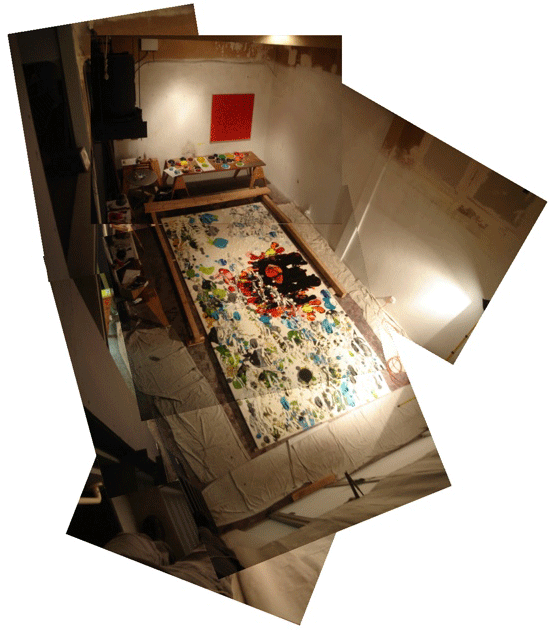
I got a little monomaniacal.
More multitasking to come.
February 7, 2007
A Crossroads of Time and Desire
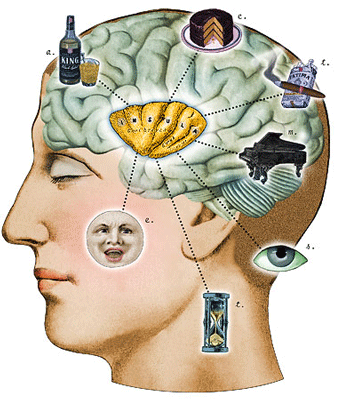
Is there a neural locus for the artistic impulse?
...lesions in the frontal insula can wipe out the ability to appreciate the emotional content of music.This NYTimes article didn't connect this newly appreciated region of the brain to art per se, but why not? The scientists however, are getting more precise:
The second major modification to the insula is a type of cell found in only humans, great apes, whales and possibly elephants, Dr. Allman said. Humans have by far the greatest number of these cells, which are called VENs, short forVon Economo neurons. VENs are large cigar-shaped cells tapered at each end, and they are found exclusively in the frontal insula and anterior cingulate cortex.VON ECONOMO NEURONS!
Economy?
How do you connect the idea of economy to art?
Occam's Razor?
Exactly what VENs are doing within this critical circuit is not yet known, Dr. Allman said. But they are in the catbird seat for turning feelings and emotions into actions and intentions.Ok, maybe these are NeoExpressionist neurons.
February 5, 2007
February 4, 2007
The Revolution Never Ended
Modernity* in motion.
Feel the acceleration.
(via the Orthodox Anarchist)
The accretion of tiny marvels can numb us to the arrival of the stupendous. Today, at any Net terminal, you can get: an amazing variety of music and video, an evolving encyclopedia, weather forecasts, help wanted ads, satellite images of anyplace on Earth, up-to-the-minute news from around the globe, tax forms, TV guides, road maps with driving directions, real-time stock quotes, telephone numbers, real estate listings with virtual walk-throughs, pictures of just about anything, sports scores, places to buy almost anything, records of political contributions, library catalogs, appliance manuals, live traffic reports, archives to major newspapers - all wrapped up in an interactive index that really works.This view is spookily godlike. You can switch your gaze of a spot in the world from map to satellite to 3-D just by clicking. Recall the past? It's there. Or listen to the daily complaints and travails of almost anyone who blogs (and doesn't everyone?). I doubt angels have a better view of humanity.
Why aren't we more amazed by this fullness? Kings of old would have gone to war to win such abilities. Only small children would have dreamed such a magic window could be real. I have reviewed the expectations of waking adults and wise experts, and I can affirm that this comprehensive wealth of material, available on demand and free of charge, was not in anyone's scenario. Ten years ago, anyone silly enough to trumpet the above list as a vision of the near future would have been confronted by the evidence: There wasn't enough money in all the investment firms in the entire world to fund such a cornucopia. The success of the Web at this scale was impossible.
But if we have learned anything in the past decade, it is the plausibility of the impossible.
* For those who split hairs between the modern and the postmodern, you can't be the latter without being the former first.
Antiepithalamium 1
Kevin O'Sullivan sent me the the first effort of Pharmakos Film,
Pharmacy stalwart John Tottenham's on-camera rendition
of Antiepithalamium 1.
Pharmacy has been producing short dramas on the second floor of the Mountain bar, and now with YouTube, they can upload shorter dramatic shorts, thus applying a few more joules of revolutionary torque mentioned previously.
February 3, 2007
February 2, 2007
Behold, the torque of the revolution!
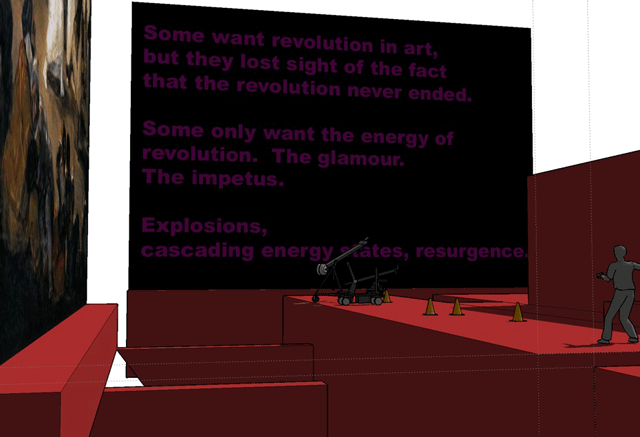
A chance to be the next Sister Wendy via castings on Craigs List, a chance to make a SuperBowl ad?
Behold, the torque of the revolution!
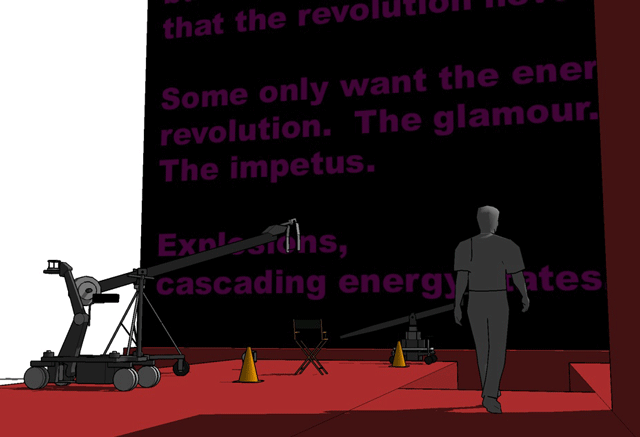
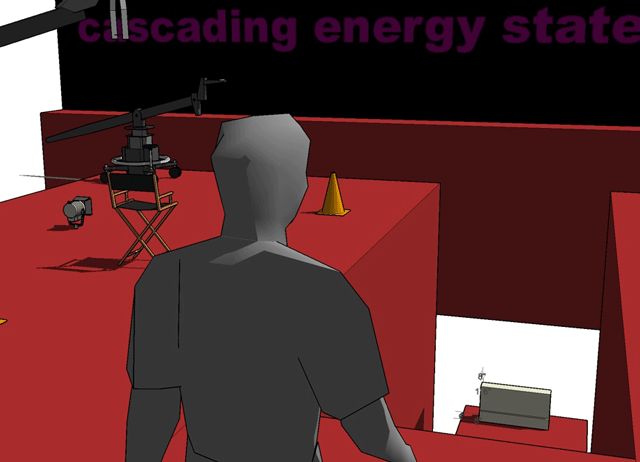
February 1, 2007
Toolz
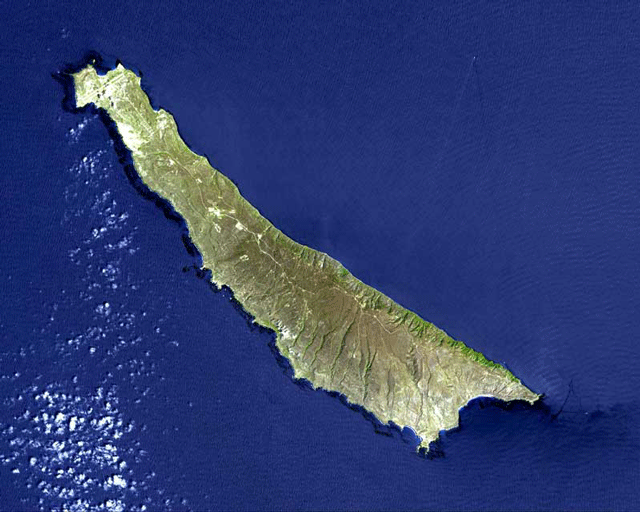
If you want skillz, you got to have some toolz.
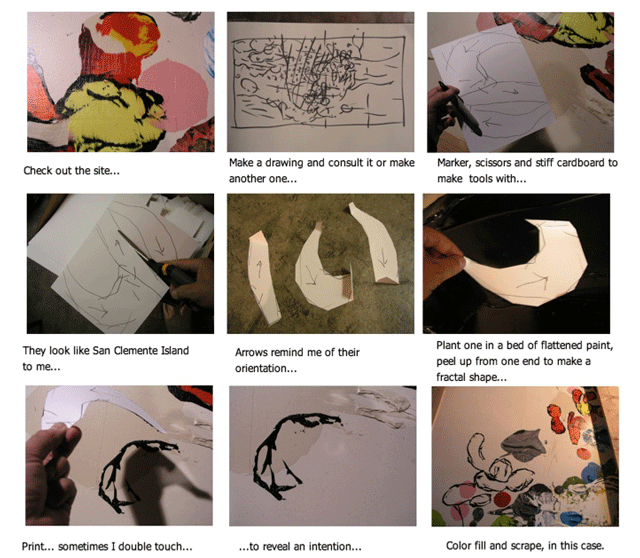
(I think the south end of the island was a NGSF practice site when I was a sailor. It was like playing the board game "Battleship" when I was a kid, but more elaborate.)
(Image.)
Near Dark, Reviewed.
Jaret Keene reviews Near Dark for Las Vegas' City Life:
Art ReviewsDarkness on the edge of town
Exhibit draws inspiration from B-grade horror filmby JARRET KEENE
IT'S NOT EVERY CONTEMPORARY ART SHOW that aligns itself with some obscure, white-trash, weird-Western vampire flick from the '80s. Curated by British artist Neal Rock, Near Dark pays homage to the Kathryn Bigelow-directed movie of the same name, bringing to light the eerier works of Los Angeles and Las Vegas artists. Although this exhibit bears no obvious "Gothic Western" imagery, there is a shared atmosphere of cross-genre playfulness and moody textures, making UNLV's Donna Beam Fine Art Gallery a crepuscular place to stop and ponder the dusty margins of popular culture, the boredom of suburban existence, the fragmentation of self in a media-saturated era. You know, the heavy stuff.
Speaking of heavy, Neal Rock's giant silicon installations look solid enough to cause the gallery's walls to shudder. Two works from his Faith Culture series are on display here, looking like giant melted candles from some epic Catholic mass. Gouged in certain spots, these funnel-cake candelabras sometimes boast hideous wounds. Upon second glance, however, they're just waxy holes again, in the same way a B-movie protagonist suddenly sees fangs in her beloved's smile.Pearl C. Hsiung's "Guanocano," meanwhile, erupts with enameled color, its luscious lava spurting rather sexually from purple volcano lips draped with a pearl necklace. "Oculus Sinister" is another vagina dentata, albeit one that stares at the viewer with ominous intent. Is this uncanny eyeball attempting to read your mind or take it over? Hard to tell.
Caroline Castano chooses to explore the notion of gender as a fluid construct rather than dwell on apocalyptic imagery. Her mixed-media efforts, "Silence of the Sirens" and "Hair Boys," reinforce the exhibit's mission to illuminate works "stuck in the middle of somewhere, trying to figure it out." Castano's beautiful boy faces adorned by elegant, overflowing hairstyles gain a shadowy edge thanks to their juxtaposition against the aforementioned "Oculus Sinister," as well as the Day for Night series, courtesy of British artist Peter Lamb. Lamb's collages of figures besieged by the pop-culture detritus of everything from Hannibal Lecter's mask to anatomy skeletons are unsettling to stand in front of, and nearly impossible to read. Are they meant to be scary? Suggestive? Whatever the intention, these pieces border on the primitivist.
For this critic, however, it's the PVC and polypropylene work of Stephen Hendee, a UNLV art prof, that resonates the most with the exhibit's idea of spectral liminality. Artificial terrains like "I'm always crashing the same car" and "Days of Quaaludes and wine" are mounted on the gallery wall like paintings, but instead look like desolate video game landscapes generated by an Atari 2600, ripped from the TV screen and crucified for our pleasure. Like Cara Cole (another Las Vegas-based artist of extreme realms), Hendee makes his apocalyptic gestures look easy. He's better known for larger installations that speak to the increasing presence of the digital in our everyday lives, but with just these three small-scale works, Hendee has me hooked on the idea that even a wasteland offers glimpses of odd beauty.
Upstairs, Gordon Cheung's Top 10 Billionaire series sits like a box of chocolates. These spray-painted portraits of folks like Bill Gates are overlayed against something akin to stock-market listings. Cheung's offerings are perhaps the most "pop" of the show -- unless you consider the shared facial features of Warren Buffet and Cthulhu. (That's a joke.) Luckily, there's Dennis Hollingsworth's single contribution, "Whistling in the Dark," a gooey evocation of twilight that feels like the proper closure for a show called Near Dark.
Naturally, there's a lot of fun to be had in a group grope like this. Unlike other anthologies that have appeared at Donna Beam in recent months, Near Dark doesn't strive to be significant in ways it can't possibly satisfy. Instead, Rock and his posse of futuristic-minded peers present viewers with a mix of styles and subject matters that share only an atmospheric concern rather than a weighty symbolic mission. Best of all, Near Dark has inspired me to hit Hollywood Video this weekend in order to locate a VHS copy of Bigelow's film.
(Image: "Work From the Faith Culture #06," by Neal Rock)
